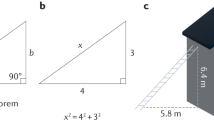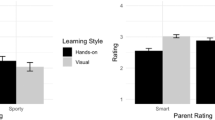Key Points
In this part, we will discuss:
-
Learning styles
-
Learning methods
-
Matching training with individual learning
Abstract
Before we can draw up our plan we need to first look at learning itself, and be aware that a number of different learning styles exist which can influence our choice of appropriate training.
Similar content being viewed by others
Main
Once the various training needs of the people in the organisation have been identified, we need to draw up a training plan that will enable us to plan the timing and cost of the various training activities required to help fill the gaps in knowledge and ability.
A training plan does not need to be very official, but it helps to write the plan down (even for a dental practice with very few people). By writing it down you can then budget training costs more realistically, integrate the training into other plans for the development of the organisation and also the development of the people within it.
Before we can draw up our plan we need to first look at learning itself, and be aware that a number of different learning styles exist which can influence our choice of appropriate training.
Learning styles
If you mention postgraduate education or training to most people in dentistry you will almost certainly find they think in terms of courses or conferences. Research has shown that attending lectures is almost always the most inefficient way of learning, yet providers of training still seem to focus on lectures and those planning CPD still tend to think of finding a course as a first choice.
However, training also incorporates such activities as workshops, distance-learning, reading books and journals, videos and interactive CDs, projects, external consultants, internal on-site training, exchange visits, small group seminars, computers, coaching, on-the-job training, shadowing, and so on. The simplistic approach to training suggests that people learn in different ways, and thus we need to provide different approaches for accessing training in response to the different ways that people learn.
The reality is perhaps different. There are a number of different theories related to how people learn. Bass and Vaughn suggested that there are five ways of learning: trial and error, perceptual organisation, behaviour modelling, mediation and reflection. These are explained more fully in Figure 1. By contrast Kolb and Honey and Mumford suggested that learning was a cycle, and from this the latter postulated four distinct learning styles: activist, reflector, theorist and pragmatist. These have been developed by Kenny and Reid and are now generally accepted as having some use in devising training activities and strategies.
To help our understanding of learning styles and their practical use in the real world it is helpful to examine the cycles of learning posed by Kolb and Honey and Mumford in more detail.
The Kolb learning cycle
Kolb believed that learning was composed of four discrete experiential methods: immersing oneself in a 'concrete' experience in a completely non-judgmental way, being able to consider that experience and reflect on it from a number of different angles, then work out rational theories based on the observations and finally put the ideas into practice to make decisions and take actions.
Kolb saw the learning process as consisting of people moving between the modes of concrete experience (CE) and abstract conceptualization (AC), (as one dimension of activity) and reflective observation (RO) and active experimentation (AE), (as the second dimension of activity). Thus the effectiveness of learning relied on the ability to balance these modes, which Kolb saw as opposite activities in the best way possible.
Thus learners tended to fall into one of four groups depending on which ends of the spectra the individual fell. Someone who tended to use the AE and AC modes was said to be using a convergent style, which emphasizes the practical application of ideas and solving problems. If you tended more towards the opposite (CE and RO) you were described as having a divergent style of learning, which meant you were more innovative and imaginative in your approach to doing things. Assimilation style involved an approach that was AC and RO dominant, which used the inductive style of reasoning where people pulled a number of different observations and thoughts into an integrated whole. Finally people who were 'doers' and used trial and error rather than thought and reflection were using the CE and AE modes. This was referred to as an accommodative style.
Thus Kolb saw learning as the way people tended to view how to learn based on their background and experiences rather than as personality traits.
The Honey and Mumford learning styles
Although Honey and Mumford have based their learning styles on a similar model (Figure 4) there are some subtle but important differences. They postulate that people tend to prefer different methods of learning, but do not see this as opposite ends of a spectrum. Instead they believe that people move between four different states of learning, which they have defined as activist, reflector, theorist, and pragmatist. These four states relate to their own version of the learning cycle whereby people have an experience, reflect on it, draw their own conclusions (theorize) and then put the theory into practice to see what happens. Based on the result they then move round the circle again if required until they are successful (in other words they have learnt).
They suggest a range of activities that will enable people with different learning styles to learn more effectively, which are obviously of use for identifying appropriate training methods, and use a questionnaire to help individuals identify their prominent learning style.
The relevance of the learning styles
Buckley and Caple have described the learning styles in their book The Theory and Practice of Training and made some observations on the validity of both models because of their reliance on the term 'experience' and the fact we lack a clear understanding of what an 'experience' is.
From the viewpoint of training the real relevance must surely be that different people do seem to learn more effectively in different ways. For some the concept of learning by activity (activist) is by far the most attractive, while others are much more reflective (reflectors) by nature and prefer to be given information and allowed time to think about it before doing anything.
Others like to analyse, think and theorize (theorists) and may well wish to carry out research before changing their behaviour, while still others (pragmatists) find learning fairly difficult if they cannot see the relevance to their jobs.
When drawing up a training plan to meet the needs of the different individuals in a dental practice we need to keep in mind the fact that we may need to devise alternative methods of learning for different people where possible and appropriate. This does not mean we only send activists on courses and only provide theorists with textbooks. What it means is an awareness that different people will learn to different degrees, and we need to consider the most effective way of using our resources (time and money) to gain the maximum benefit for the most people.
Conclusion
In order to gain benefit from the training needs analysis we need to be able to provide appropriate methods of learning for the different individuals in an organization. As people tend to learn more effectively in different ways (referred to as learning styles) we need to identify the styles of different people to try and match their style with an appropriate form of training.
Having done this we can then match up the subjects where we have identified training needs (gaps in knowledge and ability) with appropriate forms of training.
Author information
Authors and Affiliations
Corresponding author
Additional information
Refereed paper
Rights and permissions
About this article
Cite this article
Grace, M. Learning styles. Br Dent J 191, 125–128 (2001). https://doi.org/10.1038/sj.bdj.4801116
Published:
Issue Date:
DOI: https://doi.org/10.1038/sj.bdj.4801116











